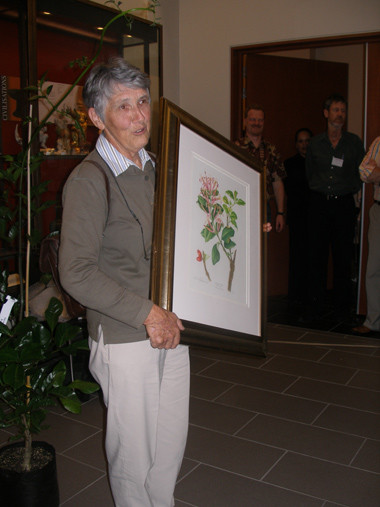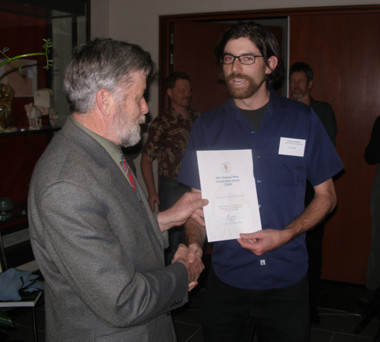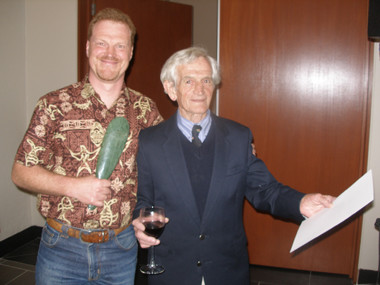 Maureen Young with her plant conservation award.The annual Plant Conservation awards were made at the Network conference in Auckland in November 2006. The awards for outstanding contribution to plant conservation went to the following recipients. Recipients of the awards were as follows
Maureen Young with her plant conservation award.The annual Plant Conservation awards were made at the Network conference in Auckland in November 2006. The awards for outstanding contribution to plant conservation went to the following recipients. Recipients of the awards were as follows
Individual Award
Maureen Young (Auckland Botanical Society)
Maureen Young is a skilled botanist. She is one of the most important advocates for plant conservation in Auckland. She has assisted the Department of Conservation with locating threatened plant sites and has volunteered time to help locate sites over many years. In terms of Auckland plant conservation, as it said on her nomination form “She is a legend”
Council award
Auckland Regional Council
 Ian Spellerberg presents the Council award to Jonathan Boow (there on behalf of the Auckland Regional Council).The work of the Auckland Regional Council spans many areas of plant conservation and it leads the country in so many of these. The Auckland Regional Botanic Garden has a threatened plant garden and native plant nursery for re-vegetation of all Auckland’s regional parks. The Natural Heritage section is involved in the re-vegetation of regional parks (75,000 native plants planted per year), species conservation programmes, biodiversity protection and restoration advocacy with landowners and community groups. The Parks Department is involved in the management of regional parks and the operational side of parks re-vegetation and conservation, plant nurseries at Arataki and Wenderholm and education programmes. Then there is the Biosecurity team that is involved with preparing and implementing the Regional Pest Management Strategy and animal and plant pest control programmes.
Ian Spellerberg presents the Council award to Jonathan Boow (there on behalf of the Auckland Regional Council).The work of the Auckland Regional Council spans many areas of plant conservation and it leads the country in so many of these. The Auckland Regional Botanic Garden has a threatened plant garden and native plant nursery for re-vegetation of all Auckland’s regional parks. The Natural Heritage section is involved in the re-vegetation of regional parks (75,000 native plants planted per year), species conservation programmes, biodiversity protection and restoration advocacy with landowners and community groups. The Parks Department is involved in the management of regional parks and the operational side of parks re-vegetation and conservation, plant nurseries at Arataki and Wenderholm and education programmes. Then there is the Biosecurity team that is involved with preparing and implementing the Regional Pest Management Strategy and animal and plant pest control programmes.
Plant nursery award
Motukarara Nursery (Canterbury)
The Department of Conservation plant nursery is a Canterbury institution providing quality plants, quality information and collaboration with many others. The Nursery’s contribution to plant conservation in Canterbury has been immense.
Community award
Kitchener Park Team (Feilding)
The members have faced huge personal problems but have come together as a team driven by the needs of Kitchener Park. The team’s story is one of the most moving plant conservation stories of the decade. Kitchener Park is 13 hectares of native bush outside Fielding that supports many podocarps and ‘the largest kowhai in New Zealand’. The team has worked to eradicate Tradescantia from the park and is replanting with locally sourced ngaio, ribbonwood and lemonwood. The team is supported by the mayor, MP and local businesses and community
School award
Newbury School (Palmerston North)
Newbury School is an Enviroschool. Its work stands out as being the most impressive by any school in New Zealand. A children-led programme of native planting has been established. Children are encouraged to persist to do the best they can in everything they attempt. Their school motto is ‘Kia Kaha - Attitude is Everything’.
Lifetime achievement award
Brian Molloy
 Life time Achievement award winner Brian Molloy alongside Peter de Lange, 2006 recipient of the Allan Mere AwardBrian Molloyhas been a key figure in the New Zealand plant conservation movement. He was one of the first to see the need for threatened plant management - mainly through his work with Hebe armstrongii at the Enys Reserve in the early 1970s and in his role with the Queen Elizabeth Trust and on the Mt Peel Conservation Board. Brian is still a member of the Riccarton Bush Board of Trustees. He has been mentor to many people including David Given and Peter de Lange. He has never been afraid to speak his mind and his most memorable statement that has earned him the undying love of many botanists is his frank assessment of DOC’s attitudes at his 1990 Loder Cup award ceremony “DOC has a fixation on saving what is feathered or farts….”! Brian is also a taxonomist and because of his past work he has had a kowhai named after him (Sophora molloyi).
Life time Achievement award winner Brian Molloy alongside Peter de Lange, 2006 recipient of the Allan Mere AwardBrian Molloyhas been a key figure in the New Zealand plant conservation movement. He was one of the first to see the need for threatened plant management - mainly through his work with Hebe armstrongii at the Enys Reserve in the early 1970s and in his role with the Queen Elizabeth Trust and on the Mt Peel Conservation Board. Brian is still a member of the Riccarton Bush Board of Trustees. He has been mentor to many people including David Given and Peter de Lange. He has never been afraid to speak his mind and his most memorable statement that has earned him the undying love of many botanists is his frank assessment of DOC’s attitudes at his 1990 Loder Cup award ceremony “DOC has a fixation on saving what is feathered or farts….”! Brian is also a taxonomist and because of his past work he has had a kowhai named after him (Sophora molloyi).
